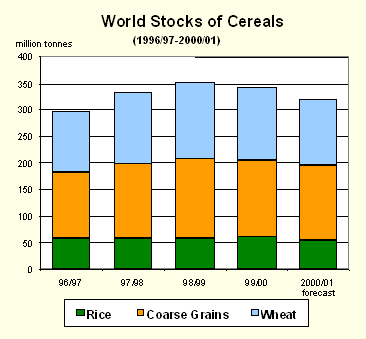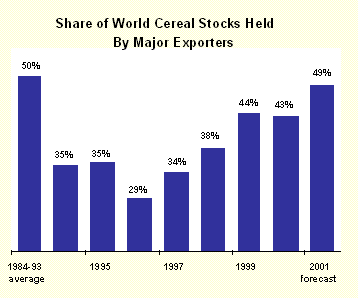


The forecast for global cereal stocks by the close of the seasons ending in 2001 has been lowered slightly since the previous report to 320 million tonnes, which is 22 million tonnes, or 6 percent, below their revised opening levels. A sharp increase in the forecast for ending stocks in the United States has been more than offset by a large downward revision to the forecast for ending stocks in China. The decline in China's cereal stocks during the current 2000/01 marketing season follows the recent downward adjustments to 2000 production forecasts for wheat, maize and rice. At the current forecast level, the ratio of global cereal carryovers to trend utilization in 2001/2002 is 16.5 percent, almost unchanged from the forecast in June and slightly below the 17 to 18 percent range that the FAO Secretariat considers the minimum necessary to safeguard world food security.

Although at the global level total cereal stocks are forecast to decline this season, there are a number of indications that those held by major exporting countries are sufficient to meet any unexpected increase in world demand this season. Aggregate cereal inventories held by the major exporters of wheat, coarse grains and rice are forecast to rise this season by at least 8 million tonnes to 156 million tonnes, despite a decline in China's stocks, one of the world's leading rice exporters. Overall, the likely expansion in cereal stocks in major exporting countries could boost their share to nearly 49 percent of the world total, from 43 percent in the previous season. The ratio of the volume of cereal stocks held by the major exporters to the total disappearance (their domestic cereal consumption plus exports) in 2000/01 is likely to remain unchanged from the previous year. For coarse grains, the anticipated increase in production in the major exporting countries is expected to result in a recovery in the stocks-to-disappearance ratio for coarse grains, from 18 percent in 1999/2000 to 20 percent in 2000/01. The ratio for wheat is likely to remain unchanged, at around 22 percent, while for rice, it is expected to fall sharply, from 11 percent in 1999/2000 to 8 percent in 2000/01, largely because of a decline in rice production in China.
| Crop year ending in: | |||
| 1999 | 2000 estimate | 2001 forecast | |
| (. . . million tonnes . . .) | |||
| Wheat | 143.0 | 138.1 | 127.1 |
| Coarse grains | 152.3 | 143.3 | 138.8 |
| Rice (milled) | 56.7 | 60.3 | 53.8 |
| TOTAL | 352.1 | 341.7 | 319.7 |
| of which: | |||
| Main exporters | 155.1 | 148.1 | 155.6 |
| Others | 196.9 | 193.6 | 164.0 |
Source: FAO
World stocks of wheat for crop years ending in 2001 are currently put at around 127 million tonnes, which represents a slight downward revision from the previous report. At this level, world wheat inventories would be 11 million tonnes, or 8 percent, below the previous year's volume. Among the world's five major wheat exporters, the anticipated 3 million tonnes rise in stocks in the EC, due to record production 2000, would more than offset the aggregate reduction of carryovers among other exporters. Although this season's large supplies of lower quality wheat are expected to encourage feed use, especially in France, the increase will not be sufficient to absorb all the anticipated expansion in output. By contrast, ending stocks in other major exporters are forecast to be reduced, mostly because of smaller production. However, the sharpest decline in wheat stocks is expected to occur among some of the major net-wheat importing countries. The biggest decline is forecast for China, where reduced plantings and drought are expected to result in a drop of nearly 13 million tonnes in production. While imports are forecast to increase, stocks would still have to be drawn down by at least 10 million tonnes, in order to meet the expected requirements in 2000/01. Sharp drops in stock levels are also anticipated in a number of other drought-stricken countries, including Afghanistan, the Islamic Republic of Iran, Iraq, Jordan and Morocco. By contrast, wheat inventories are likely to expand in Pakistan and India because of bumper crops, while in Kazakhstan a combination of above-average wheat harvest and reduced export prospects to the Russian Federation could lead to larger carryovers.
Global coarse grain inventories for crop years ending in 2001 are currently put at 139 million tonnes, up 3 million tonnes from the previous report, but still 4 million tonnes less than the estimated opening levels. This month's downward revision mainly results from a sharp decline in the forecasts for China's maize stocks (down 13 million tonnes) and smaller stocks in a few European countries, which would more than offset the increase in the forecast for stocks in the United States. In China, maize production is expected to fall drastically this season, by as much as 20 million tonnes, or 48 percent, mostly due to drought. This is expected to result in a sharp drawdown of stocks as well as a decline in exports. Smaller stocks are also anticipated in Hungary and Poland. Adverse dry weather in central and eastern Europe during the growing season could result in smaller maize production especially in Hungary, while maize and rye output in Poland are also expected to be adversely affected.

By contrast, the latest (August) official report from the United States puts total coarse grain production of that country at a record volume, up 24 million tonnes from 1999, and 16 million tonnes more than was reported in June. Although the official forecasts for exports and total utilization (especially feed and industrial use) have also been raised, the forecast for stocks of coarse grains has been raised sharply since the previous report and now points to an expansion from 51 million tonnes at the start of the season to 67 million tonnes by the end of the season. This would bring the United States coarse grain inventories to their highest volume since 1988, the bulk of which, about 62 million tonnes, would consist of maize. The large expansion in the United States coarse grain stocks is the most important factor offsetting the expected decline in inventories in nearly all other major producing countries. In the EC, despite higher production prospects, coarse grain stocks could be reduced slightly. Although the EC barley production in 2000 is forecast to increase by about 3 million tonnes, this increase may not be sufficient to meet the likely increase in barley exports as well as feed use without drawing down stocks. Already during the past season, large export sales (particularly from the public intervention stores) resulted in a significant (about 4.5 million tonnes) decline in barley stocks in the EC.

World rice stocks for the marketing seasons ending in 2000 are almost unchanged from the level shown in the previous report of 60 million tonnes or 3 million tonnes above their opening level. However, for the marketing seasons ending in the year 2001, global rice stocks are tentatively forecast to fall by 10 percent to approximately 54 million tonnes. The expected reduction is largely a reflection of a projected drop in world rice production, the first in about 13 years, coinciding with an anticipated increase in consumption. Most of the fall in inventories would be accounted for by China (Mainland) where stocks are expected to shrink by 37 percent reflecting an anticipated contraction in paddy output and based on similar export shipments to those witnessed since 1997. However, the decline in China's stocks could be less than suggested, if the country restrains exports in 2001. It should, however, be noted that the final global rice stocks' level will be influenced, among other things, by the 2001 paddy harvests in some countries whose outcome is yet to be known.